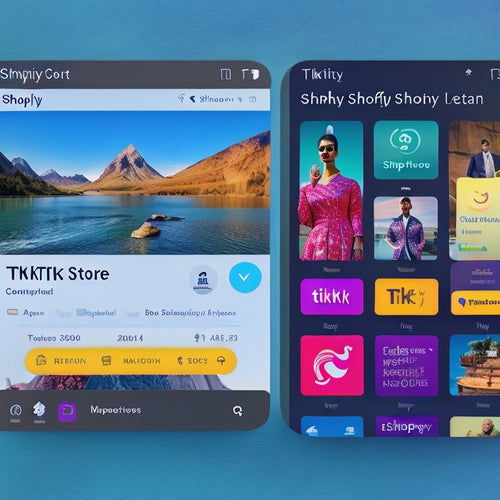
Unlock the Power: Google Merchant Center Strategies
Share
To access the power of Google Merchant Center, ecommerce businesses must strategically optimize product listings with potent keywords and accurate information, implement effective feed management strategies, and improve conversion optimization to drive high-quality traffic. Regularly updating inventory levels, optimizing product titles and descriptions, and setting precise shipping and tax settings are also essential for success. By balancing free and paid listing strategies, conducting competitive analysis, and targeting high-intent customers, businesses can maximize online visibility and drive sales and revenue. Now, discover how to take your ecommerce business to the next level by mastering these strategies and more.
Key Takeaways
• Strategically optimize product listings with potent keywords and accurate information to drive high-quality traffic and conversions.
• Leverage free and paid listing strategies to balance visibility, budget, and customer targeting, and conduct competitive analysis.
• Regularly update inventory levels, optimize product titles and descriptions, and set precise shipping and tax settings for enhanced product visibility.
• Verify account and associate with website, set accurate shipping settings, and ensure tax accuracy to guarantee successful product listings.
• Drive increased online visibility, sales, and revenue by leveraging Google Merchant Center to target high-intent customers with optimized product listings and targeted advertising.
Maximizing Google Merchant Center
To maximize the potential of Google Merchant Center, eCommerce merchants must strategically optimize their product listings. This involves leveraging potent keywords, accurate product information, and effective feed management strategies to increase online visibility, drive sales, and enhance their online presence.
By doing so, merchants can improve conversion optimization by providing customers with clear and concise product information, increasing the likelihood of a sale. Targeted advertising is also pivotal, enabling merchants to reach their desired audience and drive high-quality traffic to their site.
By implementing these strategies, merchants can increase their online visibility, drive sales, and ultimately enhance their online presence.
Optimizing Inventory for Success
Accurate and up-to-date inventory management is crucial for eCommerce success, as it directly impacts product visibility, customer satisfaction, and ultimately, sales revenue. Effective inventory optimization guarantees that products are accurately represented, reducing the risk of overselling or underselling. This, in turn, leads to increased customer satisfaction and loyalty.
| Inventory Optimization Strategies | Benefits | Best Practices |
|---|---|---|
| Regularly update inventory levels | Enhanced product visibility | Use automated inventory management tools |
| Optimize product titles and descriptions | Increased conversions | Include relevant keywords and phrases |
| Set precise shipping and tax settings | Reduced errors and returns | Verify settings with shipping carriers and tax authorities |
Free and Paid Listing Strategies
By effectively utilizing both free and paid product listings in Google Merchant Center, eCommerce businesses can strategically balance visibility, budget, and customer targeting to drive sales and revenue growth.
Free listings provide an opportunity to reach a wider audience, while paid ads can be used to target high-intent customers with strategic pricing and targeted keywords.
Conducting a competitive analysis can help identify gaps in the market and inform ad performance optimization.
By leveraging both free and paid listings, businesses can maximize their online visibility, attract high-quality traffic, and drive conversions.
A data-driven approach can help refine listing strategies, ensuring a strong return on investment and sustained growth.
Setting Up for Success
When setting up a Google Merchant Center account, a methodical approach is crucial to guarantee a seamless setup process and best performance, as it lays the foundation for effective product listing and feed management.
To guarantee a successful setup, focus on the following key areas:
-
Account verification and website association: Verify your account and associate it with your website to establish a secure connection.
-
Shipping settings: Set up accurate shipping settings to avoid disapprovals and guarantee a smooth customer experience.
-
Tax accuracy: Ensure tax settings are precise to comply with regulations and prevent errors.
- Feed management: Create a detailed product feed to guarantee successful product listings and optimize performance.
Leveraging Google Merchant Center
Through strategic optimization and effective feed management, eCommerce merchants can unveil the full potential of Google Merchant Center, driving increased online visibility, sales, and revenue.
By leveraging Google Merchant Center, merchants can enhance product visibility across various Google platforms, including Search, Maps, and Shopping tab. This increased exposure can lead to targeted advertising, allowing merchants to attract high-intent customers who are more likely to convert.
By optimizing product listings with relevant keywords and information, merchants can guarantee their products appear in front of the right audience, driving sales and revenue.
Achieving Ecommerce Excellence
To attain ecommerce excellence, merchants must prioritize a data-driven approach, meticulously analyzing customer behavior, sales trends, and product performance to inform strategic decisions and optimize their online storefronts.
This involves leveraging Google Merchant Center insights to refine product listings, improve customer experience, and drive conversions. By doing so, merchants can:
- Identify opportunities for ecommerce expansion and capitalize on them
- Develop targeted marketing strategies for strategic growth
- Optimize product feeds for maximum visibility and reach
- Continuously monitor and adjust their approach to stay ahead of the competition
Unlocking Online Sales Potential
By strategically utilizing Google Merchant Center's features and best practices, eCommerce merchants can harness their online sales potential by maximizing product visibility, driving conversions, and ultimately, boosting revenue.
To access this potential, merchants should focus on improving conversion rates by optimizing product listings with relevant keywords, high-quality images, and detailed product information. This enables effective targeting of customers who are more likely to make a purchase.
By doing so, merchants can increase the visibility of their products, drive more qualified traffic to their site, and ultimately, improve their online sales performance.
Frequently Asked Questions
Can I Use Google Merchant Center With a Non-Ecommerce Website?
While Google Merchant Center is designed for eCommerce sites, non-profit organizations and personal blogs can leverage its marketing strategies by creating content around products or services, like educational resources or event tickets, to reach a broader audience.
How Often Should I Update My Product Feed for Optimal Performance?
To maximize performance, update your product feed at least daily, leveraging feed optimization and performance analysis to identify areas for improvement. Implementing product feed automation and prioritizing data accuracy also helps maintain a high-quality feed.
Are There Any Product Categories Restricted From Google Merchant Center?
To guarantee compliance, merchants should familiarize themselves with Google Merchant Center's guidelines, as certain product categories, such as prohibited products like counterfeit goods and restricted items like firearms, are barred from listing to maintain a safe and trustworthy shopping environment.
Can I Use Google Merchant Center for Multiple Websites or Domains?
To utilize Google Merchant Center for multiple websites or domains, create separate accounts for each website, adhering to domain restrictions and best practices, ensuring accurate setup and avoiding policy violations.
Is Google Merchant Center Compatible With Third-Party Ecommerce Platforms?
Google Merchant Center seamlessly integrates with most third-party ecommerce platforms, ensuring compatibility and effortless setup, while also allowing non-ecommerce websites to optimize product listings and leverage its robust features for unparalleled online visibility.
Related Posts
-
What Do Shopify Sitemap Apps Offer Your Store?
This article aims to provide an informative overview of the benefits and features offered by Shopify sitemap apps fo...
-

How Do I Enable TikTok Integration on My Shopify Store
The integration of TikTok on Shopify stores has gained attention due to its potential benefits for businesses. This ...
-

Building a Successful Shopify App: Challenges and Strategies
This article explores the challenges and strategies involved in building a successful Shopify app. A Shopify app is ...

